
The Bermuda sloop is a historical type of fore-and-aft rigged single-masted sailing vessel developed on the islands of Bermuda in the 17th century. Such vessels originally had gaff rigs with quadrilateral sails, but evolved to use the Bermuda rig with triangular sails. Although the Bermuda sloop is often described as a development of the narrower-beamed Jamaica sloop, which dates from the 1670s, the high, raked masts and triangular sails of the Bermuda rig are rooted in a tradition of Bermudian boat design dating from the earliest decades of the 17th century. It is distinguished from other vessels with the triangular Bermuda rig, which may have multiple masts or may not have evolved in hull form from the traditional designs.

Mystic Seaport Museum or Mystic Seaport: The Museum of America and the Sea in Mystic, Connecticut is the largest maritime museum in the United States. It is notable for its collection of sailing ships and boats and for the re-creation of the crafts and fabric of an entire 19th-century seafaring village. It consists of more than 60 historic buildings, most of them rare commercial structures moved to the 19-acre (0.077 km2) site and meticulously restored.
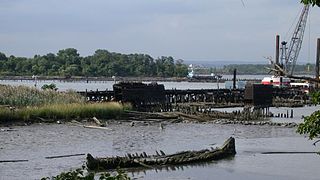
The Antique Boat Museum is a located in the 1000 Islands on the St. Lawrence River, in Clayton, New York, United States. The Antique Boat Museum is the premier freshwater boating museum in North America. The ABM's collections hold over 320 unique boats and thousands of related artifacts and archives. The 4.5-acre campus comes alive with speedboat rides, a working skiff livery, and educational programs. It is the site for the country's longest, continuously running annual Antique Boat Show and Auction. The museum has seasonal hours and is open from the first Friday in May to the end of October.
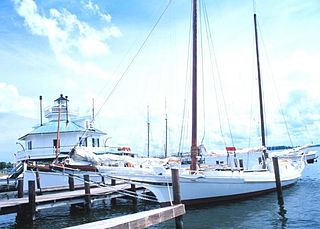
The bugeye is a type of sailboat developed in the Chesapeake Bay for oyster dredging. The predecessor of the skipjack, it was superseded by the latter as oyster harvests dropped.

The Rudolph Oyster House is a historic seafood processing building on the grounds of the Long Island Maritime Museum in West Sayville, New York. Built in 1908, it is a rare well-preserved example of a typical oyster culling house of the early 20th century, of which many once lined the local waterfront. The building was designated a National Historic Landmark in 2001.

Priscilla is a classic oyster dredging sloop and museum ship at the Long Island Maritime Museum. Built in 1888, it is the oldest surviving boat from the Great South Bay oyster fleet, and was designated a National Historic Landmark in 2006. It is berthed near the Modesty, another National Historic Landmark sloop.

Modesty was an oyster sloop built in 1923 by The Wood and Chute Shipyard of Greenport, Long Island, and is now located at the Long Island Maritime Museum in West Sayville, New York.
Priscilla as the name of a ship may refer to:

A fishing dredge, also known as a scallop dredge or oyster dredge, is a kind of dredge which is towed along the bottom of the sea by a fishing boat in order to collect a targeted edible bottom-dwelling species. The gear is used to fish for scallops, oysters and other species of clams, crabs, and sea cucumber. The dredge is then winched up into the boat and emptied. Dredges are also used in connection with the work of the naturalist in marine biology, notably on the Challenger Expedition.

The Calvert Marine Museum is a maritime museum located in Solomons, Maryland.
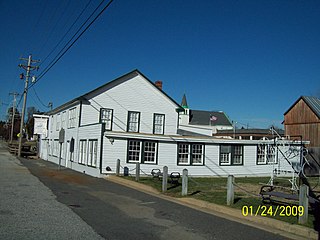
J. C. Lore Oyster House, also known as J. C. Lore and Sons, Inc., Seafood Packing Plant, is located at 14430 Solomons Island Road South, in Solomons, Calvert County, Maryland. It is a large two story, rectangular frame industrial building constructed in 1934 as a seafood packing plant. It replaced a 1922 building that was destroyed by the 1933 Chesapeake Potomac hurricane. It is significant for its historical association with the commercial fisheries of Maryland's Patuxent River region, and architecturally as a substantially unaltered example of an early-20th century seafood packing plant. It has been adapted by the Calvert Marine Museum to house exhibits and many of its original spaces, artifacts, and records have been incorporated into them.

E.C. Collier is a Chesapeake Bay skipjack, built in 1910 at Deal Island, Maryland. She is a 52-foot-long (16 m) two-sail bateau, or "V"-bottomed deadrise type of centerboard sloop. She has a beam of 17.9 feet (5.5 m), a depth of 4.5 feet (1.4 m), and a registered net tonnage of 14 tons. She is one of the 35 surviving traditional Chesapeake Bay skipjacks and a member of the last commercial sailing fleet in the United States. At the time of her documentation on the National Register of Historic Places she was located at Tilghman, Talbot County, Maryland. She is now a permanent exhibit at the Chesapeake Bay Maritime Museum in Saint Michaels, Maryland.
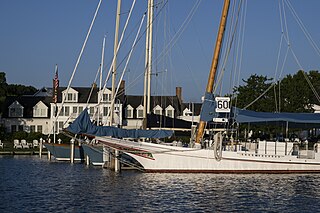
The Stanley Norman is a Chesapeake Bay skipjack, built in 1902 by Otis Lloyd, Salisbury, Maryland. She is a 48-foot-3-inch-long (14.71 m) in Length overall with length on deck (LOD) OF 47.5-foot-long (14.5 m) two-sail bateau, or "V"-bottomed deadrise type of centerboard sloop. She has a beam of 16 feet (4.9 m), a depth of 4 feet (1.2 m) at the stern with the centerboard up, and a registered tonnage of 7 tons.
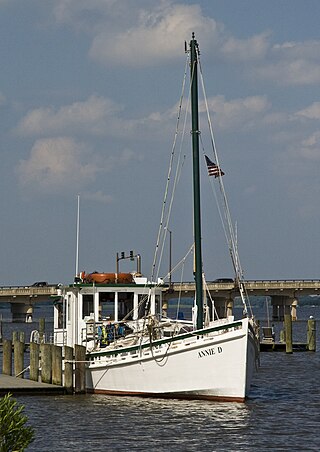
An oyster buy-boat, also known as deck boat, is an approximately 40–90 foot long wooden boat with a large open deck which serviced oyster tongers and dredgers. Similar in function to sardine carriers, buy boats circulated among the harvesters collecting their catches, then delivered their loads to a wholesaler or oyster processing house. This spared the fishermen the task and its downtime, allowing them to catch more oysters. Buy-boats also bought seed oysters, or spat, for planting in oyster beds.
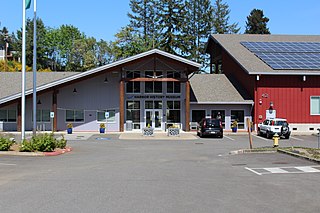
The Harbor History Museum is a regional maritime and history museum in Gig Harbor, Washington. It hosts exhibits on regional culture and history, and Midway Schoolhouse, a one-room schoolhouse built in 1893 and moved to the museum's grounds in 2009. The museum won the Washington Museum Association annual Award of Project Excellence for an ongoing living history program called Midway Pioneer School Experience that leads grade-school students through a day in an early 20th century classroom.

The Michigan Maritime Museum is a museum and research library located in South Haven in the U.S. state of Michigan. The museum is located next to the Dyckman Avenue bascule bridge on the Black River just in from Lake Michigan, the second-largest by volume of the five Great Lakes. The museum specializes in the maritime history of the state of Michigan and the lake of the same name.
The Menger Cat 19, also sold as the Thom Cat 19 Catboat, is an American trailerable sailboat that was designed by father and son team Bill Menger and Andrew Menger as a daysailer and cruiser and first built in 1990.

















